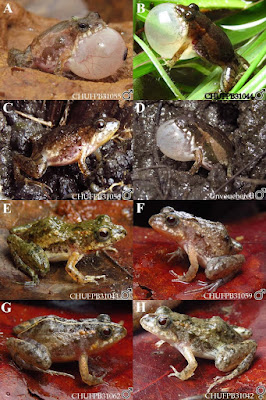 |
| Pseudopaludicola javae Silva, Andrade, Neto, Dantas, Haga & Garda, 2023 DOI: 10.1670/22-062 |
Abstract
The number of described species of Pseudopaludicola has increased at unprecedented rates over the past two decades. This increase was mainly driven by the sampling effort in regions historically neglected and the use of evidence from bioacoustic, genetic, and morphological datasets combined. Here, we describe a new species of Pseudopaludicola from a transitional zone between Amazonia and Cerrado in western Tocantins State as revealed through morphological, molecular, and bioacoustic analysis. Pseudopaludicola javae sp. nov. is distinguished from its congeners by its small size; knobbed terminal phalanges; smooth upper eyelids and heel; relatively short hind limbs; smooth, whitish, and subgular inflated vocal sac with few melanophores around the jaw; and advertisement call composed of an irregular series of multipulsed notes with 10–17 nonconcatenated pulses separated by intervals of 3–55 ms, emitted at a rate of 27–51 pulses/sec. The new species occurs in four Tocantins municipalities, all in the Araguaia–Tocantins interfluve. We also provide the first records of Pseudopaludicola jazmynmcdonaldae outside the type locality (Caseara Municipality, Tocantins State), extending its distribution nearly 245 km southward from Caseara. Pseudopaludicola javae sp. nov. is the second species of Pseudopaludicola described recently from western Tocantins.
Pseudopaludicola javae sp. nov.
Etymology.—The Javaé are an ethnic group that has been historically present in the regions surrounding the middle Araguaia River, primarily on the world’s largest fluvial island, Bananal Island. This island is flanked on its west side by the Araguaia River and to the east by the Javaés River, which is an anabranch of the Araguaia, also known as ‘‘Braço Menor do Araguaia.’’ Besides the Javaé, Bananal Island is also home to two other indigenous groups, as follows: Karaja ́ and Xambioa ́ . The Javaé people refer to themselves as Iñy, meaning ‘‘human being.’’More than 10 Javaé villages are present on Bananal Island, and the closest village to the type locality is ‘‘Boto Velho’’ village (Inãwébohona in the Iñy language), about 100 km away. Thus, the specific name is in recognition of this singular Brazilian ethnic group that historically occupied the region where the new speciesis found.
Leandro Alves Silva, Felipe Silva De Andrade, Ennio Painkow Neto, Silionamã Pereira Dantas, Isabelle Aquemi Haga and Adrian Antonio Garda. 2023. A New Species of Pseudopaludicola Miranda-Ribeiro, 1926 (Anura, Leptodactylidae) from Tocantins State, Brazil. J. of Herpetology. 57(3):297-314. DOI: 10.1670/22-062
Researchgate.net/publication/376371785_A_New_Species_of_Pseudopaludicola_from_Tocantins_State_Brazil
O número de espécies de Pseudopaludicola descritas cresceu a taxas sem precedentes nas últimas duas décadas. Esse aumento foi impulsionado principalmente pelo esforço de amostragem em regiões historicamente negligenciadas e pelo uso de evidências bioacústicas, genéticas e morfológicas. Nós descrevemos uma nova espécie de Pseudopaludicola de uma zona de transição entre a Amazônia e o Cerrado no oeste do estado do Tocantins revelada através de análises morfológicas, moleculares e bioacústicas. Pseudopaludicola javae sp. nov. é diagnosticada de seus congêneres por seu pequeno tamanho, falanges terminais simples, pálpebras superiores e calcanhar lisos, membros posteriores relativamente curtos, saco vocal subgular, liso e esbranquiçado quando inflado com poucos melanóforos ao redor da mandíbula, e canto de anúncio composto por séries irregulares de notas com 10–17 pulsos não concatenados separados por intervalos de 3–55 ms, emitidos a uma taxa de 27–51 pulsos/s. A nova espécie ocorre em quatro municípios do Tocantins, todos no interflúvio Araguaia-Tocantins. Também fornecemos aqui os primeiros registros de P. jazmynmcdonaldae fora da localidade tipo (município de Caseara, estado do Tocantins), estendendo sua distribuição em cerca de 245 km em linha reta ao sul de Caseara. Pseudopaludicola javae sp. nov. é a segunda espécie de Pseudopaludicola descrita para o oeste do Tocantins nos últimos anos.

